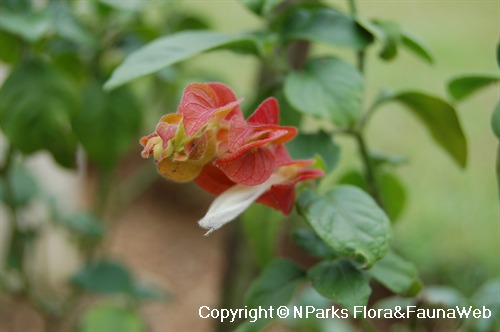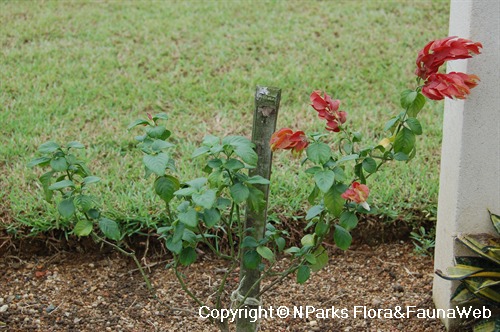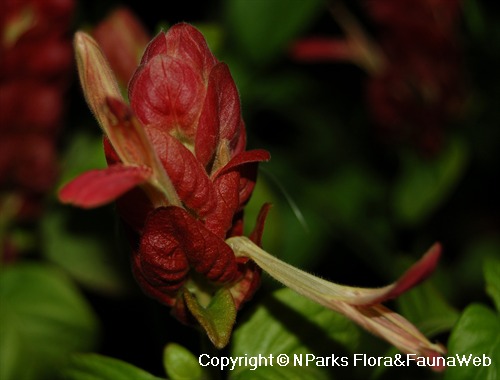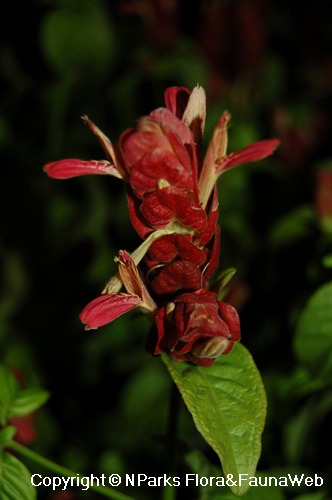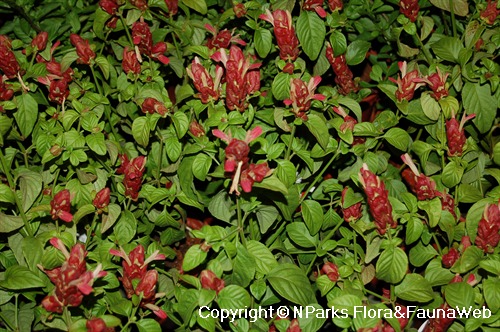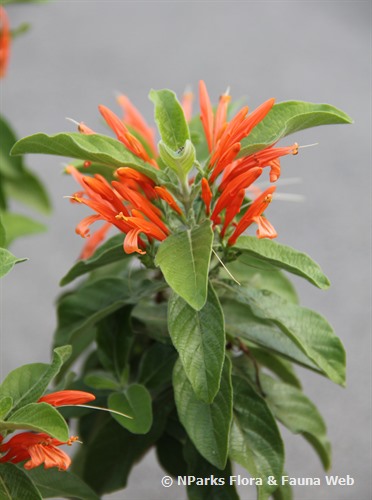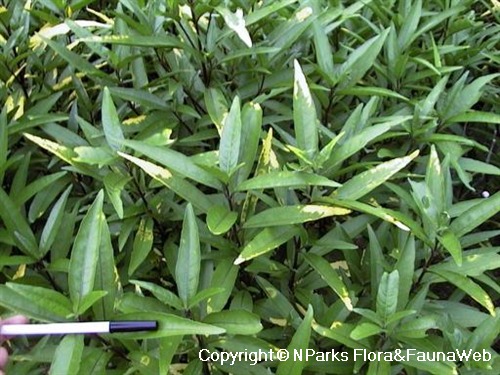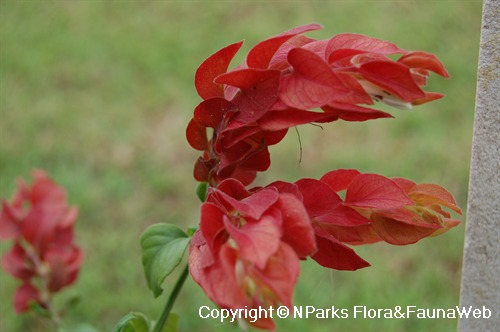
Back
Justicia brandegeeana Wassh. & L.B.Sm.
| Family Name: | Acanthaceae |
| Synonyms: | Drejerella guttata, Beloperone guttata |
| Common Name: | Shrimp Plant, Mexican Shrimp Plant, Shrimpbush, False Hop, Brazilian Shower Plant, Fountain Plant |
Name
Classifications and Characteristics
| Plant Division | Angiosperms (Flowering Seed Plants) (Dicotyledon) |
|---|---|
| Plant Growth Form | Shrub |
| Lifespan (in Singapore) | Perennial |
| Mode of Nutrition | Autotrophic |
| Maximum Height | 1.8 m |
Biogeography
| Native Distribution | Northeast Mexico |
|---|---|
| Native Habitat | Terrestrial |
| Local Conservation Status | Non-native |
Description and Ethnobotany
| Growth Form | Low, broadleaf, evergreen shrub. |
|---|---|
| Foliage | Leaves opposite and ovate (3 - 9 cm long, 2 - 5 cm wide) with entire leaf margin. |
| Flowers | Red to reddish-orange, ovate bracts (2.5 cm long) are pubescent (having soft hairs) and overlap one another in a straight or curved form (10 - 15 cm long). Actual flowers are located between the bracts in a spike inflorescence. They are tubular, bi-labiate and white with purple to red spots on the lower lip. Although flowers last only a few days, the bracts remain fresh for months. |
| Fruit | Fruits are egg-shaped or oblong capsules (dry, dehiscent fruits) that are 1 cm long. Each capsule contains 2 to 4 smooth, ovate seeds (3 mm long). |
| Habitat | Often grown in tropical and subtropical gardens. |
| Cultivation | This species is easy to grow and requires little maintenance. Plant in soil with good drainage and protect plants from wind. It grows best in humid climates. Fertilize regularly, because this species is a heavy feeder. Insufficient lighting will result in leggy plants that produce few inflorescences, so plant in full sun if possible. Older plants will also become leggy, so hard prune them to promote growth of new shoots. Growing points can be removed to promote branching. Mature plants can withstand short periods of drought, but will not tolerate saline soils. Mulch plants to help maintain soil moisture. It can be grown indoors if provided direct sunlight. This species is prone to attack by caterpillars when grown outdoors, while whiteflies and spider mites may be a problem when plants are grown indoors. |
| Etymology | The genus "Justicia" was named after James Justice, a horticulturalist from Scotland (1730-1763). The species epithet "brandegeeana" was named after Townsend Brandegee, a civil engineer from the U.S.A. who published research on plants native to California and Mexico. Although the species epithet is spelled as "brandegeana" in some horticultural books, the correct spelling is "brandegeeana". The common name of Shrimp Plant is derived from the shrimp-like appearance of the arching floral spike. |
Landscaping Features
| Landscaping | This species will make a colourful border or hedge that blooms throughout the year. The bright, long-lasting bracts make this species an ideal accent plant. |
|---|---|
| Desirable Plant Features | Ornamental Flowers |
Fauna, Pollination and Dispersal
| Pollination Method(s) | Biotic (Fauna) (Insects (Bee)) |
|---|
Plant Care and Propagation
| Light Preference | Full Sun |
|---|---|
| Water Preference | Moderate Water |
| Plant Growth Rate | Moderate |
| Rootzone Tolerance | Fertile Loamy Soils, Well-Drained Soils |
| Maintenance Requirements | Low |
| Diseases | caterpillars, whiteflies, spider mites |
| Propagation Method | Stem Cutting, Division |
Foliar
| Mature Foliage Colour(s) | Green |
|---|---|
| Mature Foliage Texture(s) | Rough |
| Foliar Type | Simple / Unifoliate |
| Foliar Arrangement Along Stem | Opposite |
| Foliar Shape(s) | Non-Palm Foliage (Ovate) |
| Foliar Venation | Pinnate / Net |
| Foliar Margin | Entire |
| Foliar Apex - Tip | Acute |
| Foliar Base | Rounded / Obtuse |
| Typical Foliar Area | Mesophyll ( 45cm2 - 182.25 cm2 ) |
| Leaf Area Index (LAI) for Green Plot Ratio | 4.5 (Shrub & Groundcover - Dicot) |
Floral (Angiosperm)
| Flower Colour(s) | Red |
|---|---|
| Flower Symmetry | Bilateral |
| Individual Flower Shape | Tubular |
| Flower Size - Remarks | Inflorescence is 10 - 15 cm long. |
| Inflorescence Type | Spike |
| Flowering Period | Free-Flowering |
| Flower Lifespan on Plant | Several Weeks |
| Flowering Habit | Polycarpic |
Image Repository
Others
| Master ID | 861 |
|---|---|
| Species ID | 2156 |
| Flora Disclaimer | The information in this website has been compiled from reliable sources, such as reference works on medicinal plants. It is not a substitute for medical advice or treatment and NParks does not purport to provide any medical advice. Readers should always consult his/her physician before using or consuming a plant for medicinal purposes. |

